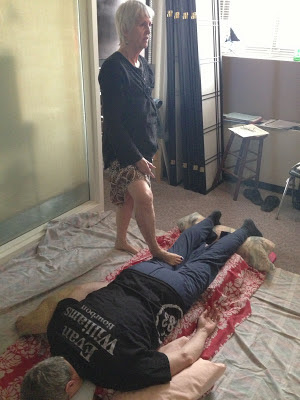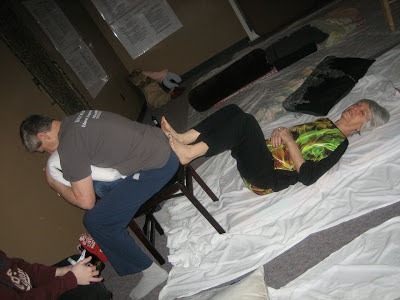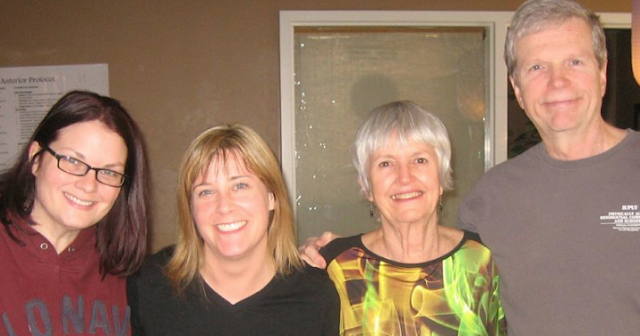Manual Therapy for the Anterior Neck
By Dawn Lewis
Recently I read an article about a woman suing a massage
therapist and Massage Envy. The woman
believes that the massage therapist was aggressive enough on her anterior neck
that it lead to a stroke. I do not know
if this is possible, but I do not know that it is impossible. Since that article there have been multiple
facebook postings about why bodyworkers should be afraid of the anterior
neck. This I completely disagree with.
We do not make bodywork safer for our clients by being
afraid of their bodies or what is happening to them. We make bodywork safer for our clients by
being as educated as we can be. There
are times when we need to send our clients to medical professionals such as
doctors, physical therapists, or chiropractors.
But when we see an apparently healthy individual and we are afraid to
touch certain areas of their bodies, we do ourselves and our clients a
disservice.
 We do not make bodywork safer for our clients by being afraid of their bodies
We do not make bodywork safer for our clients by being afraid of their bodies
The anterior neck, in particular, is an area we should all
know how to work. Why? Because humans spend a good deal of their
time right now with their necks in flexion and their heads down looking at
their devices. This leads to shortened,
tight musculature in the anterior neck.
Shortened, tight musculature in the anterior neck can cause a multitude
of issues.
First, a muscle named longus colli runs the length of the
anterior cervical vertebrae. When that
muscle is tight, the cervical spine is in flexion. This pulls the lordotic curve out of the
cervical vertebrae, moving the vertebrae toward the posterior plane of the
body. As the neck straightens and moves
posterior, the clavicles and sternal manubrium move posterior as well. This position of the clavicles and manubrium
moves the upper rib cage posterior and the scapulas into abduction. As the scapulas move into abduction, the
shoulders round forward. This all
started with a shortened longus colli.
Next, we could look at longus capitis.
Longus capitis originates on the transverse
processes of C3 through C6 and inserts on anterior aspect of the bottom of the
occiput.
Again, this muscle tightens
when we have our head in flexion looking at our devices, reading a book or
magazine, doing bodywork, etc..
But this
muscle is attached to the head.
When it
tightens, it pulls the anterior aspect of the head toward the chest (think chin
toward chest).
The natural antagonist
muscles to longus capitis are the suboccipital muscles.
In this position, the suboccipital muscles
are in stretched position, leading to weakness, and the possibility for
suboccipital headaches.
Finally, a head down position leads to tension in the
muscles attaching to the hyoid bone in the anterior neck. These muscles attach the sternum, thyroid
cartilage, head, and scapula to the hyoid.
As the chin moves toward the chest, the hyoid is moved inferior and
posterior, causing tension in all the hyoid muscles. This can lead to pain and tension in the
mandible, the temporomandibular joints, or the shoulders.
It is imperative that we learn to treat the anterior neck in
an effective way. I have been teaching
anterior neck work for decades. I teach
Spontaneous Muscle Release Technique (SMRT), a positional release modality I
made up a couple of decades ago. I was
always fascinated by the anterior neck, but while in basic training for massage
therapy 23 years ago, I had a learning experience.
I was in my third level massage course, which happened to be
neuromuscular.
Please understand that I
am in no way being negative about neuromuscular therapy, I am simply telling
you about an experience I had.
One day,
another student and I decided that we really needed to practice.
We had been avoiding the neck work because we
were not very comfortable receiving it in class.
But we had to know it to pass, so we needed
to practice it.
I went first.
I did the full neuromuscular neck protocol on her. It took about an hour. That night we had class. When I saw her in class, her neck was red and
looked marbled. It looked like
hamburger, I thought. She was in
pain. I felt terrible. The red, marbled look and the pain lasted for
almost three days. This turned me off to
doing deeper work on the neck. When I
began to develop SMRT, I spent many hours studying the neck and figuring out
how I could affect the neck without causing pain.
If we look at our examples above, it is extremely easy to
relieve tension in longus colli. At one
point in my career, I was taught to go into the anterior neck, move the
esophagus to the side and cross fiber this muscle. I have it more effective to place my hand on
the top of head and manipulate the head position until I get a release in
longus colli. The pressure of my hand on
the top of the head is minimal, as are the movements I make to find the correct
position. When longus colli regains
length, the curve in the cervical spine begins to reappear.
When the flexion of the cervical vertebrae eases and the
natural lordotic curve begins to re-establish itself, the cervical spine moves
away from the posterior plane and into a more neutral position. This allows the clavicles and manubrium to
move into an anterior plane, and the scapulas to move to a more neutral
position on the back. As a side note, when the clavicles and manubrium move to
the posterior plane, as they do when the neck is too straight, a significant
amount of tension is created in lower fibers of sternocleidomastoid. Allowing the position of these bones to move
toward a more natural anterior position, instantly eases the pressure on
sternocleidomastoid.
In our next example, we had tension in longus capitis that
was causing suboccipital muscle weakness and possibly headaches. Many times this pattern leads to a report
from the client that the "problem" is at the base of their head. When we palpate the suboccipital area, it
feels tight, so we work that area. But,
I find that by again placing my hand on the top of the head and moving the head
into the needed position, longus capitis is able to release and allow the chin
to come away from the chest, which lessens the stretch on and alleviates the
pain in the suboccipital muscles.
In both of these examples, I do not have to work directly on
the anterior neck. In our third example,
however, direct anterior neck work is beneficial. SMRT allows us to do this work in a
non-intrusive, gentle fashion, while still getting the desired results. All of the hyoid muscles can be released and
returned to normal tone by working with the position of the hyoid, the thyroid
cartilage, and the sternum.
Some therapists believe that it is impossible to get the
results a client needs by working with a light touch or by working remotely
(i.e. using the head to release the neck muscles). But I believe it is impossible to get the
desired results without knowing the possible reasons for the tension in the
muscles being addressed and while working in a way that causes pain and
tension. I have taught anterior neck
work to almost 2000 therapists (and that number will continue to grow). Anterior neck work is not something to be
frightened of, it is something to be learned and understood.
In my last SMRT: head & neck class, there was a older
woman who had been doing massage for over 30 years. When we got to the anterior neck, she said to
me, "I don't really want to practice this because I will never use
it. It scares me and I will never do it
to my clients. But I don't want to
disappoint my partner either." I
encouraged her to try it in class, with the understanding that her partner
would be very vocal about whether she was hurting her or not.
45 minutes later, by releasing the anterior neck muscles,
she felt a significant change in the position of the hyoid and her partners
chin had come into an anterior plane.
Her partner sat up, rotated her head around, sighed, and said,
"that was awesome! Thank you so
much! I slept funny last night. I had a headache and that catch in my throat
that makes you want to cough all the time, feels like a knife stuck in your
throat. It's all gone now. That was great!"
When I see training experiences like this, I get rather
irritated at the facebook posts that insight fear and tell us to stop treating
this area immediately.
It is essential
that we work on the anterior neck, yet most of the students in my SMRT courses
do not work this area when they come to class.
Within the few hours that we concentrate on the anterior neck, they
become confident in their ability to effect change without causing pain.
If you feel you do not know enough to work
this area, by all means, don't - until you have taken a class, and then by all
means, do work the anterior neck.
Dawn Lewis owns Full Circle School and teaches Spontaneous Muscle Release Technique or SMRT. Please check out the Full Circle website for live seminar dates, course videos, free sample videos, and other articles. http://efullcircle.com/



























